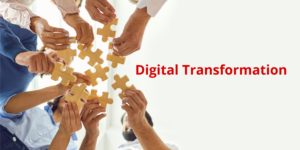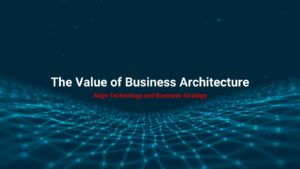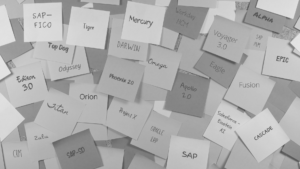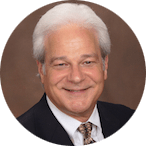The last few months have clarified WHY we need to change, and that the time is NOW. Only a few senior leaders are still wondering or resisting that premise. The real challenge, for the entire executive team, is to think about the WHAT. What should we do about it?
If we zoom way out, what has really changed is the nature and speed of change itself. Significant change has always been driven by innovation and invention. From the wheel to the printing press, to the internal combustion engine, to the personal computer, the internet, and the smartphone, we’ve seen the world evolve. But the pace of change has moved from being measured in centuries to lifetimes to generations to decades to years, and now to just months and weeks.

This makes it very hard to commit to any specific, long-term strategy or investment. We are all bombarded on a daily, or even an hourly cadence, by management consulting and technology firms advocating the latest buzzword laden catchphrases – Omnichannel, Artificial Intelligence, Customer Experience, Supply Chain Optimization, Blockchain, Robotics, Innovation Labs, Digital Business, Industry Convergence, Internet of Things, etc. Some of these topics are valid pieces and parts of a business model; some are just names of technology options. If you just stare at any one of these things, the picture is incomplete. The blur created by all of this complexity, change, and hype, can be confusing and overwhelming.
There’s a great way to think about the future vision of the WHAT – the business model – without getting lost in a game of “buzzword bingo” and the hype of the moment. Instead of zooming in on specific topics, like those above, it’s important for us to zoom out, to take a broader perspective, recognize patterns, and use our imaginations to get to the essence of the business and the capabilities needed to continuously evolve. In this blog post, I’ll share what I’ve learned, over many decades, in operating roles and in other roles working with executive and IT teams, during some of the most transformational times.
Part 2: The WHAT is Business Agility
Any successful digital transformation must start with the end in mind and describe WHAT victory would look like, without constraints. The businesses that succeed in this digital era will be those that can sense, learn and respond, and who can innovate at speed and scale.
So, as we think about the WHAT, we need to focus on the capability of the enterprise to sense-and-respond at modern speed and scale. It’s far more complicated than just reacting. We need granular, detailed, front-line knowledge plus bigger picture context and perspective to make good and timely decisions and to be able to execute them dynamically like a small, entrepreneurial company.
“Business Agility” is the sense-and-respond capability – both in the moment at a micro, tactical level and over time at a more macro, strategic level. This is what will create the next round of corporate survival of the fittest.
Those business models that have short, fast sense-and-respond OODA loops* (Observe, Orient, Decide, Act) will be the companies that SURVIVE and THRIVE. Those that have long cycle times will be the companies that won’t evolve and will eventually become extinct.
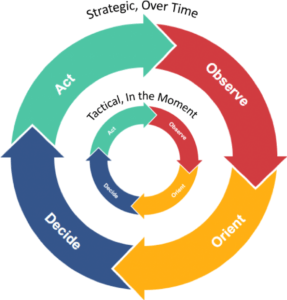
* The OODA loop is the cycle observe–orient–decide–act, developed by military strategist and United States Air Force Colonel John Boyd. Boyd applied the concept to the combat operations process, often at the operational level during military campaigns.
Frito-Lay: The Herman Lay Story
To illustrate this idea, I’d like to zoom in on one company, for one century. I spent 25 years of my career at Frito-Lay, which is a great example of a company that has continuously transformed and evolved through many eras of change. This is where I learned a pattern that still holds true today and into the future.
In 1932, Herman Lay founded the H.W. Lay Co., Inc., which later became Frito-Lay. He was an entrepreneur who was the owner, the CEO, the route salesman, the accountant, the recruiter, and he played every other role needed to run a small company. Like all great entrepreneurs, early in the life of their companies, he embodied the sense-and-respond, fast adjusting OODA loop for the company. Because he faced the retailer and the consumer each day, he had immediate, front-line, on-the-ground knowledge of how his products and his competition were doing in each store. But, as the CEO, he also had the perspective to know if his products were competitively priced and profitable, in general, across the company, and in each of the markets he served. He, therefore, knew whether or not he could afford to lower prices and whether or not discounts would be valuable enough to store owners to earn Frito-Lay some additional shelf space. And, he knew what impact that additional shelf space and additional sales would have on manufacturing and suppliers. He could use his combination of knowledge and perspective to make a smart decision about changing price, running a promotion, or introducing a new product to that store. And, he could make those decisions and take those actions on the spot, in the moment.
Almost fifty years later, when I first became the CIO of Frito-Lay, I had the good fortune to spend significant time with Herman. Although he was retired, he was still informally engaged with and passionate about the company. I sought him out just to talk about “the business” in a series of conversations. In return, he wanted me to teach him about computers. He was extremely generous with his time and loved to talk. It didn’t take much for me to grasp the simple magic of his success, and he really helped me think about what needed to happen in the future to make sure the company kept evolving and stayed competitive.
As Herman reflected on the history of the company and how far it had come, he was extremely proud that we had grown and built great new brands – like Ruffles, Cheetos, Doritos, and Tostitos – that had become household names. What alarmed him was the disconnect between the route salespeople and the senior leadership of the, now much bigger, company. Over the decades of the 20th century, as the company grew and as innovations like commercial air travel, television, interstate highways, and computers became pervasive, Frito-Lay changed dramatically. We evolved through many eras, first expanding region-by-region to eventually cover the entire country, then centralizing key functions like finance, marketing, purchasing, and manufacturing to get leverage. This was a pattern that we saw across many growing companies during the 1940s through the 1980s. Industrial Engineering was the predominant business optimization thought process of that time period. But, as the company had grown and we had centralized and functionalized many significant parts of the business, the connection between the immediacy of the knowledge (facts on the ground level, in the moment) and the perspective (context, patterns) had been fractured. The facts were atomized into the functions. Manufacturing knew about cost. Sales knew about customers and revenue. Marketing knew about products, competition, and market share. Also, the sense-and-respond gap between the time the front-line people needed to make something happen at the point of sale and the time it would take for the people at headquarters to make decisions had exploded to weeks and months. By the time we had Observed, Oriented, Decided, and Acted, it was too late, and we often caused other problems and unintended consequences. The Frito-Lay OODA loop that had started out so integrated, fast, and agile had become disconnected, slow, and inflexible.
So, our conversations went back to the beginning, back to the basics and the durable essence of the Frito-Lay business model. Herman said that the business should be really simple. We buy potatoes, cook them, put the chips in bags, bring them to the stores, delight the customers, get paid, and then use that money to buy more potatoes and do it all over again, more and more over time. Frito-Lay’s business model is “Make, Move, Sell”. According to Herman, everything else is either to support that model, or it was a waste of time and money.
Through our conversations, the WHAT, the business strategy of the future, became clear. Our WHAT, the future vision we had to make happen, was to recreate Herman’s simple, sense-and-respond, fast, and agile OODA loop working at modern speed and scale. To do this, we had to have the ability to maximize and combine both the power of the big, national platform AND the agility of an army of 10,000 route salespeople. We called this hybrid model “Directed Decentralization”. The main design of the Frito-Lay strategy, as fully documented in this Harvard Business School case study, Frito-Lay, Inc.: A Strategic Transition (Consolidated), was to leverage technology to approximate the “Founder’s Model” or “The Herman Lay Model” at modern (at the time, in the 1980s) speed and scale.
When we figured this out, here’s how fired up Herman was at his last National Sales Meeting.
The Founder Model: Learning from the Original Business Architects
Over the decades, and many transformations that I’ve led or coached leaders through since my formative years at Frito-Lay, the pattern has held across businesses, industries, and hype cycles. The same thought process and imagination that was inspired by my conversations with Herman Lay at Frito-Lay also worked in my experiences at BNSF Railway (James J. Hill), Delta Air Lines (C.E. Woolman), The Home Depot (Arthur Blank and Bernie Marcus), Southwest Airlines (Herb Kelleher), and Bank of Montreal (John Gray). These founders, and their stories, have been the inspiration for the business model transformations at these great companies. Over time, I’ve come to call this, the “Founder Model”.
Whenever I tell this story, the question often comes up, “Is this relevant in today’s world?”. My answer is an emphatic, “YES!”. During this past decade, I’ve had the honor of working with Rob Carter, the CIO of FedEx, and his extremely talented IT team. As part of that experience, I’ve been able to indirectly observe Fred Smith, FedEx’s original founder and still active Chairman and CEO. I’ve seen how Fred has managed massive growth and change. Like Herman, Herb, and others I’ve mentioned, his ability to see change coming and react is remarkable. Under Fred’s leadership, FedEx continues to both sense-and-respond in the moment, tactically, AND continuously evolve the business model strategically amid massive change and disruption.
As entrepreneurs, these founders started and ran simple, integrated, fast, and agile businesses. However, in every case, as they grew through the decades and eras, complexity, functional silos, bureaucracy, and disconnects across the Observe, Orient, Decide, and Act OODA loop crept in. Fortunately, in every case, we were able to learn from the history and the Founder Model and use our imaginations to envision an unconstrained, durable, and change-enabled future vision for the WHAT – the business model. In a way, these great founders were the original visionaries who showed us what Business Agility really means.
True Business Agility Required Three Essential Outcomes
The early, small versions of the great businesses I mentioned above all had critical capabilities like growth (products, services, geographies), productivity (bending the cost curve), intimacy (customers, employees, suppliers, partners), and cross-functional integration. Most importantly, they all had the ability to sense-and-respond tactically (in the moment) and strategically (over time). These happen to also be the capabilities, the WHAT, that every business needs now, and going forward, in order to remain successful. We can only see specifics as far as we see into the future. Don’t worry about figuring out and committing to all the details that might or might not turn out to be correct in the future. Focus on the longer-term horizon and the bigger patterns. The only real, durable business strategy is Business Agility. This is the WHAT that the entire executive team needs to embrace, and commit to investing in, as the long-term strategy.
But we can’t have Business Agility if we have Technical and Organizational Rigidity. So, to really be agile and designed for the Modern Era, we need to achieve all three essential outcomes.
- Business Outcomes (the WHAT) – “Sense-and-Respond Business Agility”
- Architectural Outcomes (the HOW) – “Built to Last Because It’s Built for Change”
- Organization Outcomes (the rest of the HOW and the WHO) – “Culture of Continuous Transformation”
Most companies’ senior leadership teams have already, or will soon figure out, the WHY. Hopefully, the ideas I have shared here and the explanation of the Founder Model will help with the WHAT. The winners and losers going forward will be determined by which companies can execute. That means we have to be great at the HOW and WHO that will actually make it happen. That’s where the unique roles of the CIO, CFO, and the CHRO come into play. In subsequent posts in this series, we’ll help these three special leaders to align on a shared vision for the Architectural and Organizational Outcomes.
Author: Charlie Feld, Founder and CEO, The Feld Group Institute
Further Learning
If you are interested in learning more about this topic, additional resources can be found on our site, including Leading The Acceleration of Digital Transformation Part 1: WHY the Time is NOW, Aligning Strategy To Business Capabilities, Business Architecture – Linking Strategic Themes To Tactical Demand, and Alignment Is Critical In Times Of Uncertainty.

